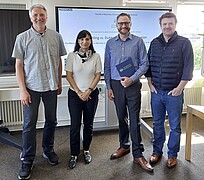Luis Noschang promoviert erfolgreich über "Subtitling vs. Dubbing an Original Version. The effects of Different Translation Methods on Consumer Behavior Towards Product Placement on Audiovisual Content" [13.05.24]
Am 13. Mai 2024 hat Luis Noschang von der Hochschule Harz erfolgreich seine kumulative Dissertationsschrift verteidigt. Wir gratulieren Dir ganz herzlich, Luis!Gutachter/in
Erstgutachter: Prof. Dr. Jens Vogelgesang
Zweitgutachter: Prof. Dr. Georg Felser
Vorsitzende der mündlichen Prüfung: Prof. Dr. Verena Hüttl-Maack
Abstract
The main objective of this dissertation was to investigate whether different versions of a program concerning audiovisual translation formats as well as multitasking would influence product placement effectiveness on audiences. Also, if there would be any relation between levels of multitasking and the version of the program being watched.
The first problem to be addressed was determining whether the above-mentioned questions have not been the subject of research in the past. A systematic search on the three most prominent research databases available (Scopus, Web of Science, and EBSCO) followed by a manual analysis of the publications was conducted and research items of these publications were further investigated to identify effects caused by placements as well as variables or drivers of product placement effectiveness.
Some 320 research items (hypotheses, research questions, empirical generalizations, and results) featured effects caused by placements. The total of effects identified was 11. Brand attitude and brand recall were the two most prominent effects identified. In the case of variables, or drivers of effectiveness, 417 research items included 57 different variables that could be divided into 2 categories: 33 variables derived from characteristics of the audience and 24 variables pertaining to the content, medium, or placement. None of the publications featured audiovisual translation formats as variables, confirming the research gap in the field. For multitasking, 2 publications were identified that covered the subject, nevertheless, in a different form than the intended of this dissertation.
The empirical investigation was performed through an experiment where participants could freely choose between four options of pre-defined episodes of two different sitcom series as well as the version between original, dubbed, and subtitled, the last only as a choice for those that could not understand the spoken dialogues. Some 2302 participants were recruited and answered a questionnaire containing questions about aided recall of brands placed in the episode, and multitasking behavior while watching the program.
Results on brand recall of placements remained constant between groups watching different versions of the programs. Punctual percentual differences could be identified, nevertheless, reversed results appeared for different products, and Chi-square tests revealed no statistically significant differences. The presence of subtitles did not significantly alter brand recall. Brand recall also remained stable among viewers of programs in original, dubbed, and subtitled versions.
Results compared brand recall of placements between viewers who declared that they engaged in other activities while watching the program and viewers who did not multitask. The levels of brand recall did not differ significantly between these two groups.
The time spent not looking at the screen was the next aspect evaluated in the experiment. Here, no significant difference in the levels of brand recall was identified between the viewers who did not look at the screen for less than 1 minute and the viewers who looked away from the screen for between 1 and 5 minutes during programs of around 20 minutes in length.
The different versions of the program were tested with regard to their influence on multitasking behavior. The presence of subtitles decreased viewers’ levels of multitasking when compared with those of viewers who watched the program in its original or dubbed versions with no subtitles added to enhance comprehension of the spoken dialogues. The levels of multitasking remained constant between viewers of the dubbed and original versions of the program.
To increase the validity of the results, a method of observing the respondents was also implemented. A total of 274 respondents were recorded in videos that were later analyzed manually. This method was introduced to more precisely determine the time they spent not looking at the screen as well as to detect false positives on the respondents’ answers.
The average time spent not looking at the screen during the program was 2 minutes and 3 seconds, which amounts to around 10% of the total duration of the program. The main outcomes of this dissertation were that different versions of the program did not alter brand recall of placed products significantly, nor did a reasonable amount of multitasking while viewing the program. Concerning the relationship between audiovisual translation formats and multitasking, the presence of subtitles decreased levels of multitasking of viewers.


